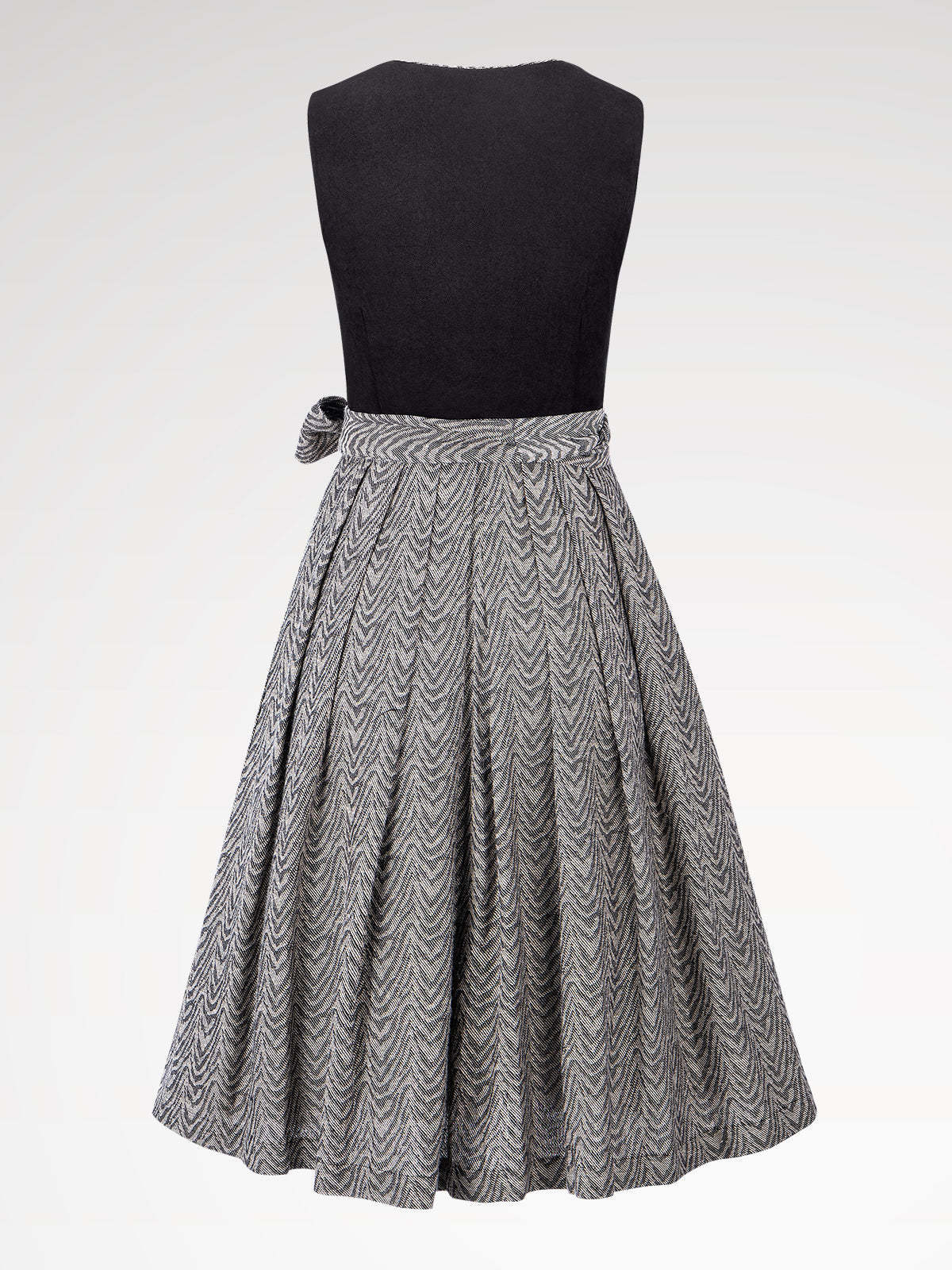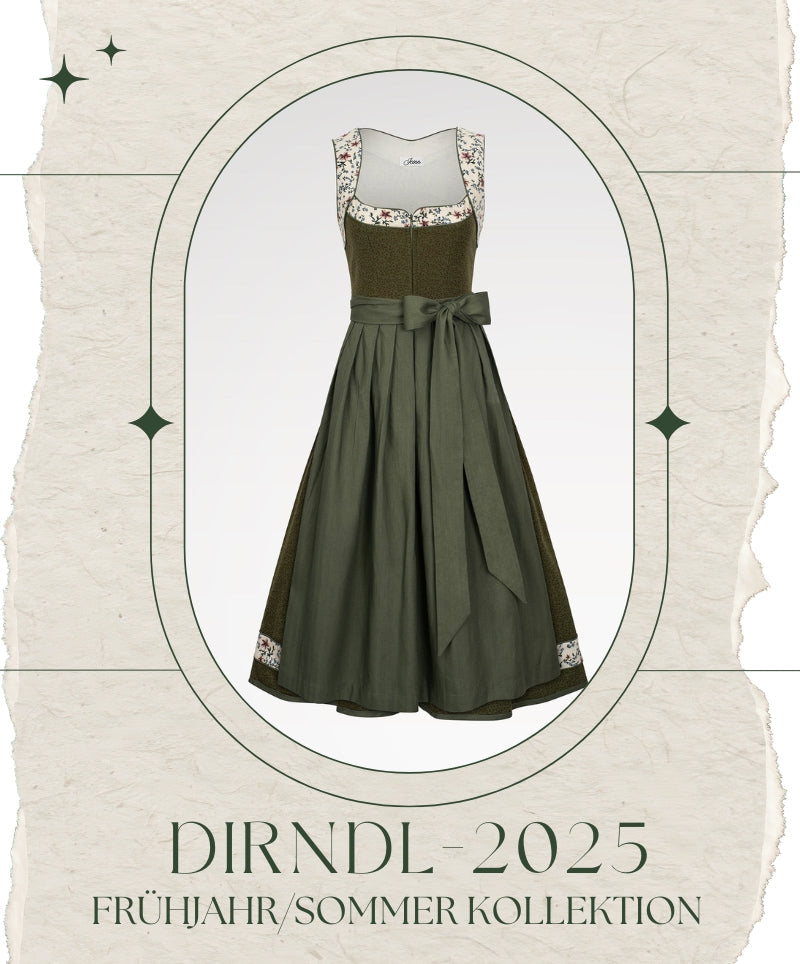I. The button-up dirndl: A plea for craftsmanship
The button-up dirndl – a term that is gaining increasing traction in the fashion world. Unlike industrially manufactured dresses with zippers or Velcro fasteners, this version relies on the traditional button placket. This construction is more than just a fashionable detail: it embodies a commitment to quality, durability, and the appreciation of craftsmanship.
1.1 History of the button placket
As early as the 19th century, buttons were an essential part of traditional clothing. They served not only as a practical fastening function, but also as an expression of social affiliation. The number and type of buttons could indicate the wearer's origin and status. Today's designers take up this heritage and reinterpret it. For example, modern button-up dirndl handmade wooden buttons from regional workshops or delicate metal buttons in traditional patterns.
1.2 Aesthetics and functionality
The button panel gives the dirndl a clear silhouette and elegantly emphasizes the female figure. At the same time, it allows for individual adjustment: Depending on the body type, the garment can be precisely tailored to the body. This combination of aesthetics and functionality makes the button-up dirndl a popular companion for festivals, weddings or simply for everyday use.
II. The green dirndl blouse: a symbol of closeness to nature and modernity
Green – the color of nature, hope and renewal. green dirndl blouse has become a real it-piece in recent years. Why? Because it combines tradition with contemporary design and enables a new interpretation of the dirndl.
2.1 Traditional meaning of green
In traditional costumes, green traditionally represented a connection to nature and rural culture. Green blouses were particularly popular in rural areas, where the color reflected the surroundings. Today, however, green is also interpreted as an expression of modern environmental awareness. Many wearers choose the green dirndl blouse to underline her commitment to sustainability and regionality.
2.2 Design variety of the green dirndl blouse
From delicate mint to strong emerald green to dark forest green – the palette of green dirndl blouse is diverse. Designers experiment with different cuts, materials, and patterns. You can find both classic blouses with gathers and embroidery and modern versions with minimalist lines and innovative prints. Combining them with a dark apron or a contrasting skirt makes the green dirndl blouse shine in any case.
III. The thankfully green dirndl: A phenomenon of modernity
The term thank goodness dirndl green is more than just a product name. It represents an entire movement that is taking the dirndl out of the traditional dress drawer and giving it a place in the modern wardrobe.
3.1 The brand behind the name
"Thank God" – a word that expresses relief and gratitude. The brand of the same name has set itself the task of combining traditional craftsmanship with contemporary design. dirndl green is more than just a piece of clothing: It's a statement of individuality, quality, and sustainability. The collections are manufactured in small factories, with a focus on regional materials and fair working conditions.
3.2 The concept of the “green dirndl”
The thank goodness dirndl green breaks with old-fashioned ideas about traditional costume fashion.It focuses on clean lines, modern cuts, and innovative materials. At the same time, it remains committed to tradition: many models feature traditional elements such as the button placket and apron in a modern interpretation. The result is a dress that's an eye-catcher both at Oktoberfest and in the city.
IV. The Future of the Dirndl: Tradition in Motion
The button-up dirndl, the green dirndl blouse and that thank goodness dirndl green are not isolated cases, but part of a larger trend. They demonstrate that traditional clothing doesn't have to gather dust in a museum; on the contrary, it can inspire, excite, and raise awareness of cultural heritage among new generations.
4.1 Sustainability as a driving force
An important aspect of this development is the increasing importance of sustainability. Many customers value regional production, fair working conditions, and environmentally friendly materials. button-up dirndl and that thank goodness dirndl green meet these demands and set new standards in the fashion industry.
4.2 The role of digitalization
Digitalization also plays a role in the dirndl's renaissance. Social media platforms like Instagram and Pinterest have helped make traditional clothing known to a wider audience. Influencers and bloggers present their dirndls in modern contexts and inspire their followers with new styling ideas.





Leave a comment
This site is protected by hCaptcha and the hCaptcha Privacy Policy and Terms of Service apply.